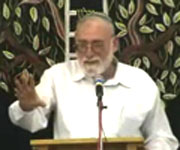Beit Midrash
- Shabbat and Holidays
- Purim & The Month of Adar
- The Laws of Purim
- Sections
- Peninei Halakha
The Men of the Great Assembly (Anshei Knesset Ha-gedola) constituted the supreme beit din that functioned at the beginning of the Second Temple period. It was comprised of 120 elders, among them prophets and sages such as Ĥagai, Zekharia, Malakhi, Daniel, Ĥanania, Mishael, Azaria, Ezra the Scribe, Neĥemia b. Ĥakhalia, Mordechai (the same Mordechai that appears in Megilat Esther), and Zerubavel b. She’altiel. Ezra the Scribe was the most prominent of all, so much so that the Men of the Great Assembly are sometimes called "The Beit Din of Ezra the Scribe." They were the great beit din that established the first major enactments that are considered rabbinic mitzvot, and they were the impetus for the continued activity of the Sages of the Oral Torah.
The Purim miracle is considered the last miracle that was allowed to be recorded in the Tanakh, as the Sages state, "Esther is the end of all the miracles" (Yoma 29a). Thus, in effect, the writing of Megilat Esther concludes the Tanakh.
Purim is the link that connects the Written Torah and the Oral Torah. This is reflected in the status of its mitzvot, which are considered divrei kabbala, an intermediate category between Torah commandments and rabbinic ones. On the one hand, they are not on the level of mitzvot that are written in the Pentateuch. On the other hand, they are not considered rabbinic mitzvot, since Megilat Esther is included in Scripture. The Rishonim disagree about how one should behave if an uncertainty arises regarding the laws of Purim: Does the halakha demand that one be stringent, as in cases of Torah commandments, or lenient, as in cases of rabbinic enactments? 2
One must perform seven mitzvot on Purim. Four of them are unique to Purim: 1) reading the Megilla; 2) mishlo’aĥ manot (sending gifts of food to a friend); 3) matanot la-evyonim (giving gifts to the poor); and 4) participating in a festive meal. The remaining three are rabbinic commandments that parallel rabbinic obligations on other holidays: 1) reading the Torah (for men); 2) commemorating the day by reciting Al Ha-nisim in our prayers and in Birkat Ha-mazon; and 3) refraining from fasting and delivering eulogies.
^ 2.Most Rishonim and Aĥaronim agree that the four special mitzvot of Purim have the status of divrei kabbala, which refers to laws that are derived from the words of the Prophets or the Writings, a category in between Torah law and rabbinic law. They only dispute the halakha in cases of uncertainty. At first glance, the fact that the Megilla is read on both the 14 th and 15 th where there is uncertainty about whether that location was walled at the time of Yehoshua bin Nun indicates that one must be stringent in cases of uncertainty, as we are with regard to Torah commandments. This appears to be the position of Rambam and SA 688:4, 696:7. According to Ramban, Rashba, and Ritva, however, we follow this practice only as a pious custom, not as an obligation, demonstrating that the status of these mitzvot is like that of rabbinic commandments. Several Aĥaronim are inclined toward stringentcy (Turei Even, MB 692:16, Kaf Ha-ĥayim 692:39). Another discussion is rooted in the same question: Does reading the Megilla override Torah commandments? Most authorities, including Rema 687:2, maintain that reading the Megilla does not override such mitzvot, but Taz rules that it does.

Matanos La’evyonim
Rabbi Yirmiyohu Kaganoff | Adar 5768
1. What Is a Walled City?
Chapter 17: Walled and Unwalled Cities
Rabbi Eliezer Melamed | Adar I 8 5782
15. Working on Purim
Chapter 15: Purim and Reading the Megilla
Rabbi Eliezer Melamed | Tevet 5 5782






















